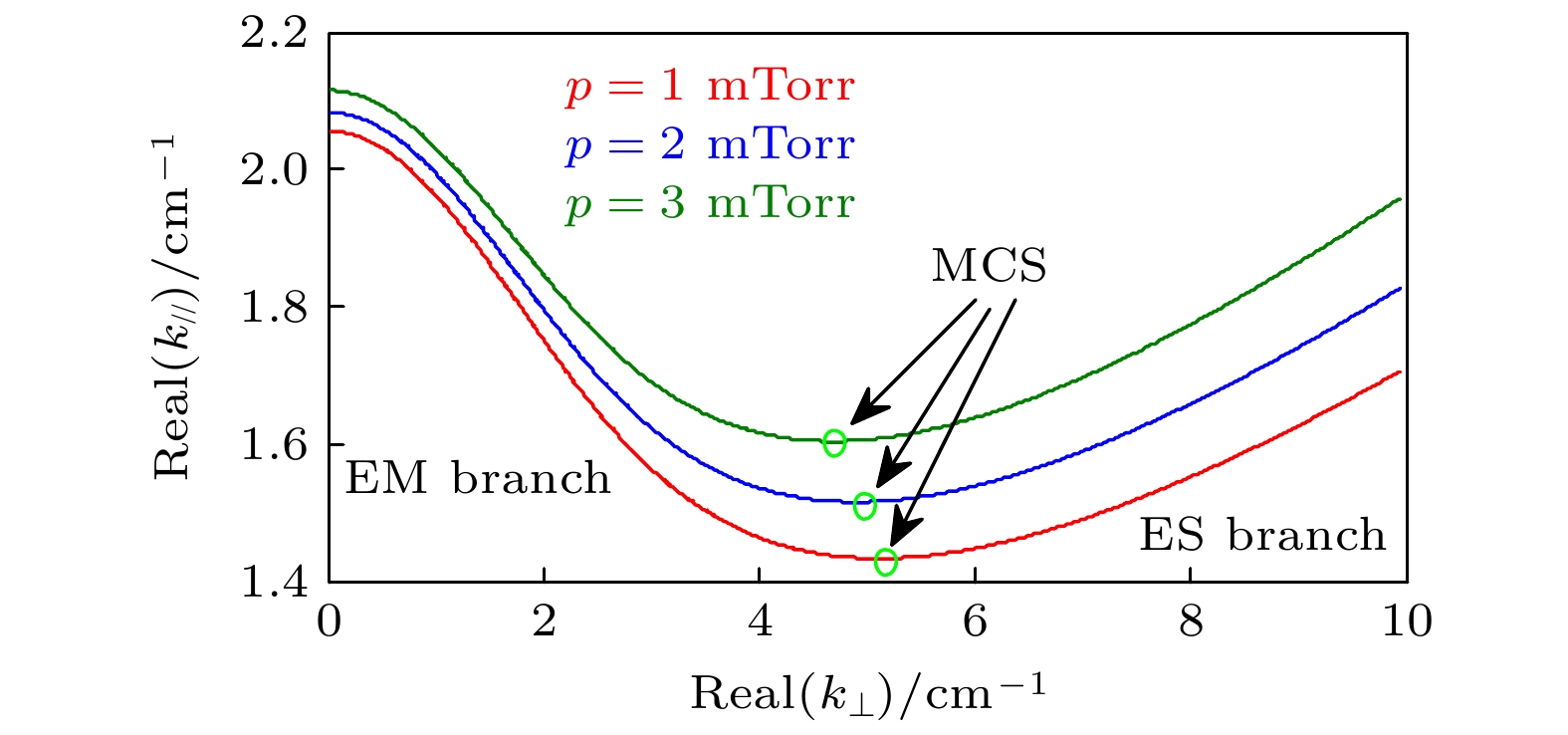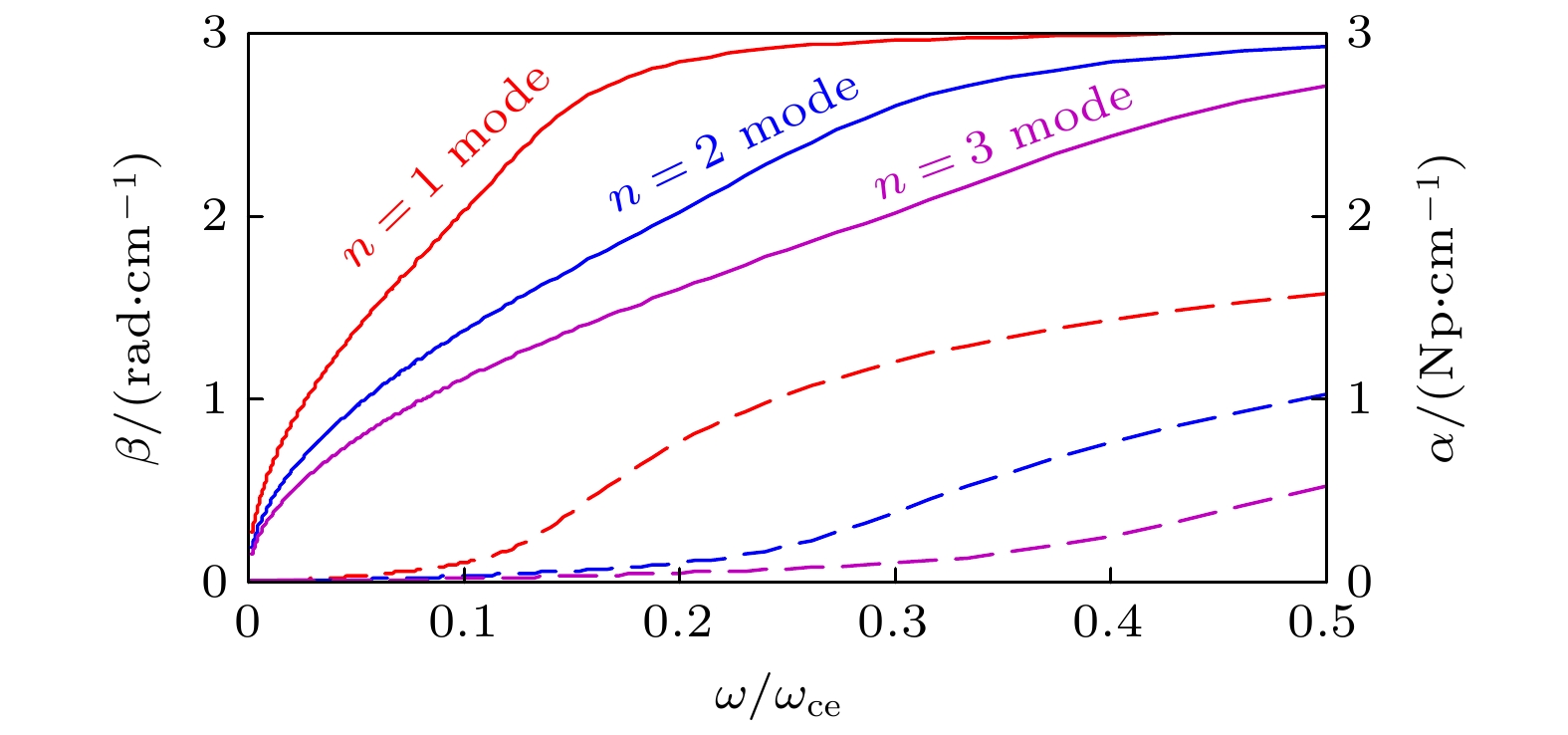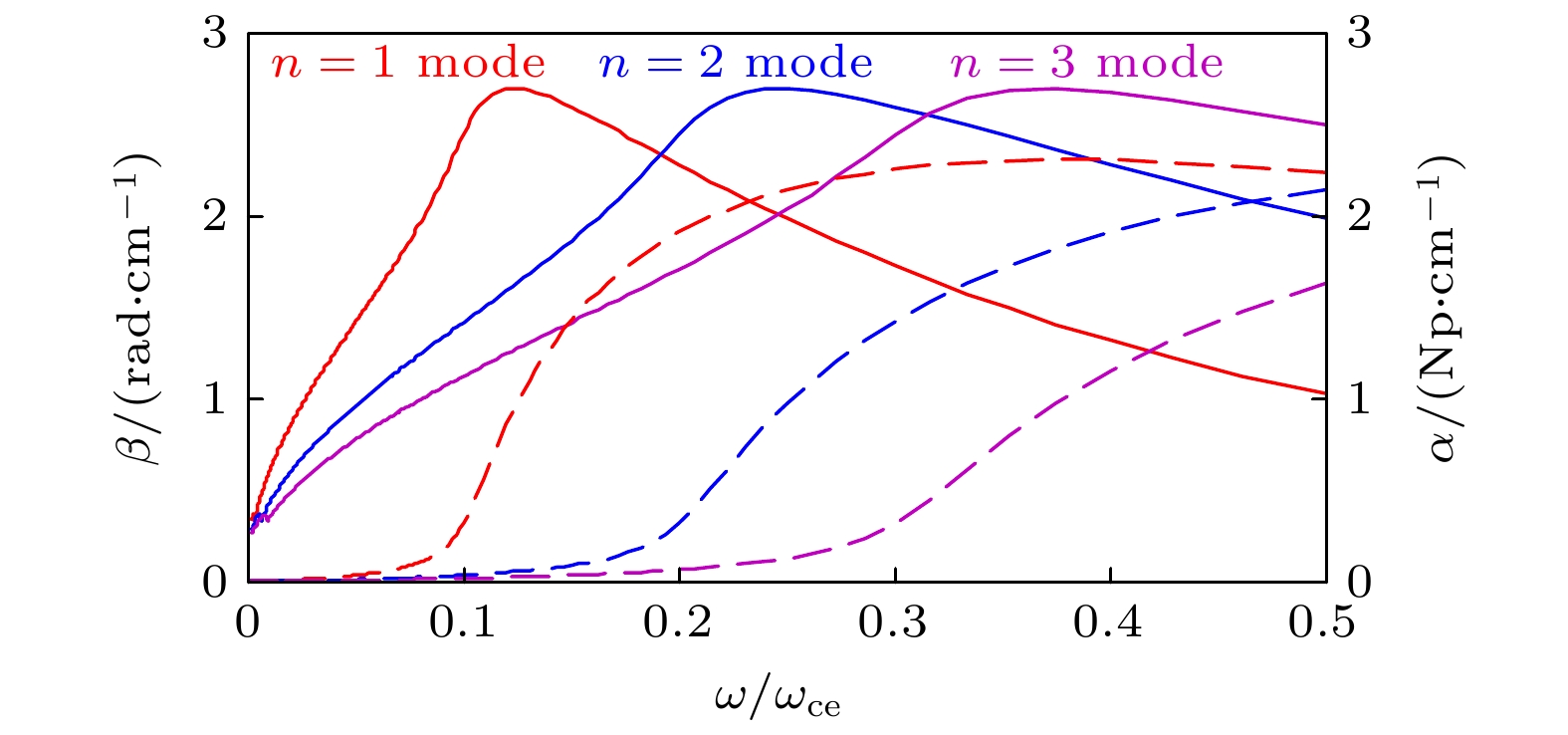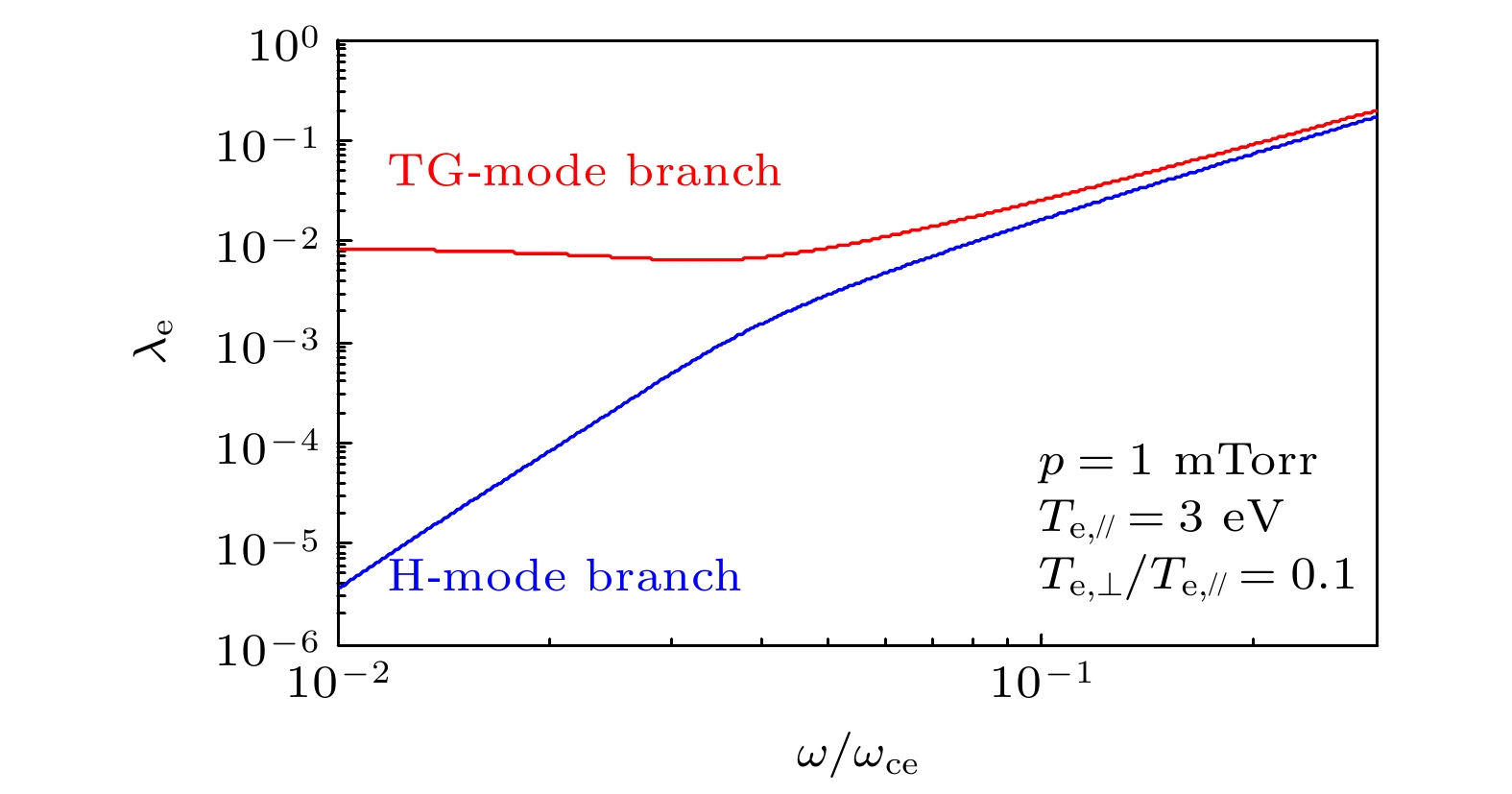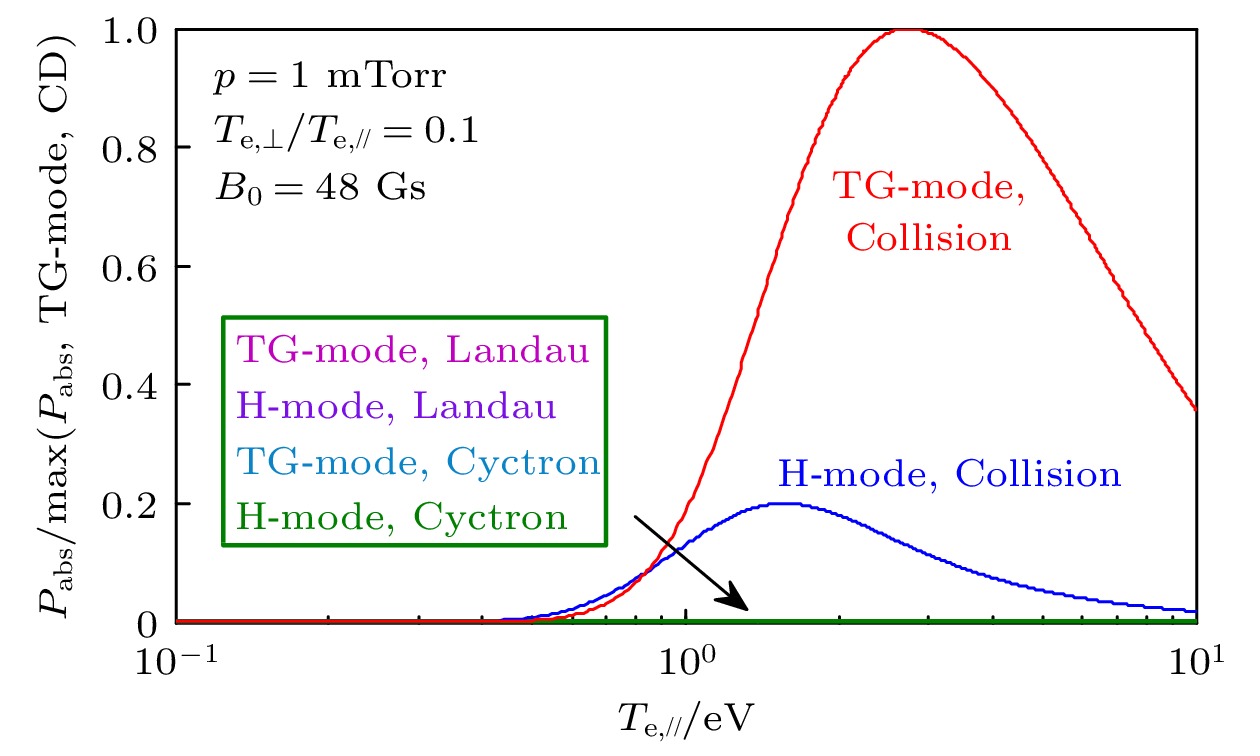-
采用考虑粒子温度各向异性热等离子体介电张量模型, 借助磁化、均匀密度分布等离子体中电磁波的一般色散关系, 在低磁场、低气压螺旋波等离子体典型参量条件下, 理论分析了电子温度各向异性对电磁模式传播特性和角向对称模功率沉积的影响. 研究结果表明: 对于给定的纵向静磁场B0 (或波频率ω), 存在一个临界波频率ωcr (或纵向静磁场B0,cr), 当ω > ωcr (或B0 < B0,cr)时, 电子回旋谐波遭受的阻尼开始显著增大; 相比粒子温度各向同性情形, 粒子温度各向异性彻底改变了波的传播特性, 即相位常数和衰减常数均出现峰值现象; 在考虑电子有限拉莫尔半径效应和电子温度各向异性情形下, Trivelpiece-Gould (TG)波碰撞阻尼在整个电磁波功率沉积中占据主导地位, 电子纵向温度Te,// 存在某一临界值, 在此临界值处TG波功率沉积出现峰值Pabs,TG, 且随着Te,⊥/Te,// 的减小, 此功率沉积峰值 Pabs,TG 逐渐增强.As the core issue in helicon discharge, the physical mechanism behind the high ionization rate phenomenon is still not fully understood. Based on the warm plasma dielectric tensor model which contains both the particle drift velocity and temperature anisotropy effect, by employing the general dispersion relation of electromagnetic waves propagating in magnetized and uniform plasma with typical helicon discharge parameter conditions, wave mode propagation characteristic and collisional, cyclotron and Landua damping induced wave power deposition properties of azimuthally symmetric mode are theoretically investigated. Systematic analysis shows the following findings. 1) Under typical helicon plasma parameter conditions, i.e. wave frequency ω/(2π)=13.56 MHz, ion temperature is one tenth of the electron temperature, and for a given magnetic field B0 (or wave frequency ω), there exists a critical wave frequency ωcr (or magnetic field B0,cr), above which (or below B0,cr) the damping of the n = 1, 2, 3 cyclotron harmonics begins to increase sharply. 2) For the electron temperature isotropic case, the attenuation constants of different harmonics start to increase significantly and monotonically at different thresholds of magnetic field, while the phase constant abruptly increases monotonically from the beginning of the parameter interval. On the other hand, for the electron temperature anisotropic case, both the phase constant and attenuation constant have peaking phenomenon, i.e. the attenuation constant begins to increase sharply at a certain value of B0 and meanwhile the phase constant presents a maximum value near the same value of magnetic field, thus the phase constant starts to keep constant at a certain value of B0 and meanwhile the attenuation constant has a maximum value near this same value of magnetic field. 3) For the wave power deposition properties, under electron temperature anisotropy conditions, power deposition due to collisional damping of Trivelpiece-Gould (TG) wave plays a dominant role in a low field (B0 = 48 Gs) (1 Gs = 10–4 T); by considering the electron finite Larmor radius (FLR) effect, the power deposition of TG wave presents a maximum value at a certain point of parallel electron temperature Te,//; with the decrease of Te,⊥/Te,//, the maximum value of power deposition increases gradually. All these findings are very important in further revealing the physical mechanism behind the high ionization rate in helicon plasma.
-
Keywords:
- helicon plasma /
- anisotropy /
- propagation characteristics /
- power deposition
[1] Varughese G, Kumari J, Pandey RS, et al. 2018 J. Mod. Appl. Phys. 2 13
[2] Omura Y, Summers D 2006 J. Geophys. Res. Space Phys. 111 A09222
[3] 倪彬彬, 赵正予, 顾旭东, 汪枫 2008 物理学报 57 7937
 Google Scholar
Google Scholar
Ni B B, Zhao Z Y, Gu X D, Wang F 2008 Acta Phys. Sin. 57 7937
 Google Scholar
Google Scholar
[4] 傅绥燕, 徐寄遥, 魏勇, 刘立波, 熊明, 曹晋滨, 宗秋刚, 王赤, 冯学尚, 史全岐, 师立勤, 任丽文 2019 中国科学: 地球科学 49 1641
Fu S Y, Xu J Y, Wei Y, Liu L B, Xiong M, Cao J B, Zong Q G, Wang C, Feng X S, Shi Q Q, Shi L Q, Ren L W 2019 Sci. Sin. Terrae 49 1641
[5] Caneses J F, Blackwell B D 2016 Plasma Sources Sci. Technol. 25 055027
 Google Scholar
Google Scholar
[6] Isayama S, Shinohara S, Hada T 2018 Plasma Fusion Res. 13 1101014
 Google Scholar
Google Scholar
[7] Shinohara S 2018 Adv. Phys. X 3 1420424
[8] Shinohara S, Hada T, Motomura T, et al. 2009 Phys. Plasmas 16 057104
 Google Scholar
Google Scholar
[9] Chen F F, Boswell R W 1997 IEEE Trans. Plasma Sci. 25 1245
 Google Scholar
Google Scholar
[10] Squire J P, Chang-Diaz F R, Jacobson V T, et al. 2003 AIP Conference Proceedings for the 15th Topical Conference on Radio Frequency Power in Plasmas Moran, May 19–21, 2003 p423
[11] Squire J P, Chang-Díaz F R, Glover T W, et al. 2006 Thin Solid Films 506 579
[12] Boswell R W, Sutherland O, Charles C, et al. 2004 Phys. Plasmas 11 5125
 Google Scholar
Google Scholar
[13] Bathgate S N, Bilek M M M, Mckenzie D R 2017 Plasma Sci. Technol. 19 083001
 Google Scholar
Google Scholar
[14] Furukawa T, Kuwahara D, Shinohara S 2020 AIAA Propulsion and Energy Forum New Orleans, August 24–26, 2020 p3630
[15] Liu X, Sun X, Guo N, et al. 2022 IEEE Trans. Plasma Sci. 7 2138
[16] Polzin K, Martin A, Little J, et al. 2020 Aerospace 7 105
 Google Scholar
Google Scholar
[17] Perry A J, Vender D, Boswell R W 1991 J. Vac. Sci. Technol. B Microelectron. Nanometer Struct. Process. Meas. Phenom. 9 310
 Google Scholar
Google Scholar
[18] Takahashi K, Motomura T, Ando A, et al. 2014 J. Phys. D Appl. Phys. 47 425201
 Google Scholar
Google Scholar
[19] Smyrnakis A, Dimitrakis P, Gogolides E 2018 J. Phys. D Appl. Phys. 51 455101
 Google Scholar
Google Scholar
[20] Goulding R H, Caughman J B O, Rapp J, et al. 2017 Fusion Sci. Technol. 72 588
 Google Scholar
Google Scholar
[21] Ivanov A A, Davydenko V I, Kotelnikov I A, et al. 2013 Fusion Sci. Technol. 63 217
 Google Scholar
Google Scholar
[22] Goulding R H, Biewer T M, Caughman J B O, et al. 2011 AIP Conference Proceedings for the 19th Topical Conference on Radio Frequency Power in Plasmas Rhode Island, June 1–3, 2011 p535
[23] Goulding R H, Chen G, Meitner S, et al. 2009 AIP Conference Proceedings for the 18th Topical Conference on Radio Frequency Power in Plasmas Belgium, June 24–26, 2009 p667
[24] Isayama S, Shinohara S, Hada T, et al. 2019 Phys. Plasmas 26 023517
 Google Scholar
Google Scholar
[25] Shinohara S 2002 J. Plasma Fusion Res. 78 5
 Google Scholar
Google Scholar
[26] Chen F F, Torreblanca H 2007 Plasma Sources Sci. Technol. 16 593
 Google Scholar
Google Scholar
[27] Tarey R D, Sahu B B, Ganguli A 2012 Phys. Plasmas 19 073520
 Google Scholar
Google Scholar
[28] Chen F F 1991 Plasma Phys. Controlled Fusion 33 339
 Google Scholar
Google Scholar
[29] Chen F F, Blackwell D D 1999 Phys. Rev. Lett. 82 2677
 Google Scholar
Google Scholar
[30] Blackwell D D, Chen F F 2001 Plasma Sources Sci. Technol. 10 226
 Google Scholar
Google Scholar
[31] Kline J L, Scime E E, Boivin R F, et al. 2002 Phys. Rev. Lett. 88 195002
 Google Scholar
Google Scholar
[32] Eom G S, Kim J, Choe W 2006 Phys. Plasmas 13 073505
 Google Scholar
Google Scholar
[33] Cho S 2020 Plasma Sources Sci. Technol. 29 095023
 Google Scholar
Google Scholar
[34] 赵高, 熊玉卿, 马超, 刘忠伟, 陈强 2014 物理学报 63 235202
 Google Scholar
Google Scholar
Zhao G, Xiong Y Q, Ma C, Liu Z W, Chen Q 2014 Acta Phys. Sin. 63 235202
 Google Scholar
Google Scholar
[35] 平兰兰, 张新军, 杨桦, 徐国盛, 苌磊, 吴东升, 吕虹, 郑长勇, 彭金花, 金海红, 何超, 甘桂华 2019 物理学报 68 205201
 Google Scholar
Google Scholar
Ping L L, Zhang X J, Yang H, Xu G S, Chang L, Wu D S, Lü H, Zheng C Y, Peng J H, Jin H H, He C, Gan G H 2019 Acta Phys. Sin. 68 205201
 Google Scholar
Google Scholar
[36] Guo X M, Scharer J, Mouzouris Y, et al. 1999 Phys. Plasmas 6 3400
 Google Scholar
Google Scholar
[37] Correyero Plaza S, Navarro J, Ahedo E 2016 52nd AIAA/SAE/ASEE Joint Propulsion Conference Salt Lake City, July 25–27, 2016 p5035
[38] Swanson D G 1989 Plasma Waves (New York: Academic Press) p155
[39] Huba J D 2016 NRL Plasma Formulary (Washington: Naval Research Laboratory) p34
[40] Mouzouris Y, Scharer J E 1998 Phys. Plasmas 5 4253
 Google Scholar
Google Scholar
[41] Fried B D, Conte S D 2015 The Plasma Dispersion Function: The Hilbert Transform of the Gaussian (New York: Academic Press) p1
[42] Sakawa Y, Kunimatsu H, Kikuchi H, et al. 2003 Phys. Rev. Lett. 90 105001
 Google Scholar
Google Scholar
[43] Shamrai K P, Taranov V B 1996 Plasma Sources Sci. Technol. 5 474
 Google Scholar
Google Scholar
[44] Chen F F, Arnush D 1997 Phys. Plasmas 4 3411
 Google Scholar
Google Scholar
-
图 4 电子温度各向同性情形下n=1, 2, 3 次回旋谐波传播常数对纵向静磁场的依赖关系 (实线代表相位常数, 虚线代表衰减常数)
Fig. 4. Dependence of propagation characteristic of the n=1, 2, 3 electron cyclotron harmonics on magnetic field in the case of electron temperature isotropy (the solid lines represent the phase constant, and the dashed lines represent the attenuation constant).
图 5 电子温度各向异性情形下n = 1, 2, 3次回旋谐波传播常数对纵向静磁场的依赖关系 (实线代表相位常数, 虚线代表衰减常数)
Fig. 5. Dependence of propagation characteristic of the n = 1, 2, 3 electron cyclotron harmonics on magnetic field in the case of electron temperature anisotropy (The solid lines represent the phase constant, and the dashed lines represent the attenuation constant).
表 1 色散关系元素
Table 1. Elements of dispersion relation.
${\varPi _{su} }$ u = 1 u = 2 u = 3 s = 1 $ {{\text{J}}_m}({k_{ \bot m, {\text{H}}}}a) $ $ {{\text{J}}_m}({k_{ \bot m, {\text{TG}}}}a) $ $ - {\text{j}}{k_{ \bot m, v}}{\text{H}}_m^{(1)}({k_{ \bot m, v}}a) $ s = 2 $\begin{gathered} k_{ \bot m, {\text{TG} } }^2\left[ {m{k_{//, m} }{ {\text{J} }_m}({k_{ \bot m, {\text{H} } } }a) } \right. \\ \left. +{ {k_{\text{H} } }{k_{ \bot m, {\text{H} } } }a{ {\text{J} }_m'} ({k_{ \bot m, {\text{H} } } }a)} \right] \\ \end{gathered}$ $\begin{gathered} k_{ \bot m, {\text{H} } }^2\left[ {m{k_{//, m} }{ {\text{J} }_m}({k_{ \bot m, {\text{TG} } } }a) } \right. \\ \left. +{ {k_{\text{H} } }{k_{ \bot m, {\text{TG} } } }a{ {\text{J} }_m'} ({k_{ \bot m, {\text{TG} } } }a)} \right] \\ \end{gathered}$ $ {\text{j}}k_{ \bot m, {\text{H}}}^2 k_{ \bot m, {\text{TG}}}^2 m{\text{H}}_m^{(1)}({k_{ \bot m, v}}a) $ s = 3 $\begin{gathered} k_{ \bot m, {\text{TG} } }^2\left[ {m{k_{\text{H} } }{ {\text{J} }_m}({k_{ \bot m, {\text{H} } } }a) } \right. \\ \left. +{ {k_{//, m} }{k_{ \bot m, {\text{H} } } }a{ {\text{J} }_m'} ({k_{ \bot m, {\text{H} } } }a)} \right] \\ \end{gathered}$ $\begin{gathered} k_{ \bot m, {\text{H} } }^2\left[ {m{k_{ {\text{TG} } } }{ {\text{J} }_m}({k_{ \bot m, {\text{TG} } } }a) } \right. \\ \left. +{ {k_{//, m} }{k_{ \bot m, {\text{TG} } } }a{ {\text{J} }_m'} ({k_{ \bot m, {\text{TG} } } }a)} \right] \\ \end{gathered}$ ${\text{j} }k_{ \bot {m}, {\text{H} } }^2 k_{ \bot {m}, {\text{TG} } }^2 {k_{ \bot {m}, v} }a{\text{H}_m^{(1)' }}({k_{ \bot {m}, v} }a)$ -
[1] Varughese G, Kumari J, Pandey RS, et al. 2018 J. Mod. Appl. Phys. 2 13
[2] Omura Y, Summers D 2006 J. Geophys. Res. Space Phys. 111 A09222
[3] 倪彬彬, 赵正予, 顾旭东, 汪枫 2008 物理学报 57 7937
 Google Scholar
Google Scholar
Ni B B, Zhao Z Y, Gu X D, Wang F 2008 Acta Phys. Sin. 57 7937
 Google Scholar
Google Scholar
[4] 傅绥燕, 徐寄遥, 魏勇, 刘立波, 熊明, 曹晋滨, 宗秋刚, 王赤, 冯学尚, 史全岐, 师立勤, 任丽文 2019 中国科学: 地球科学 49 1641
Fu S Y, Xu J Y, Wei Y, Liu L B, Xiong M, Cao J B, Zong Q G, Wang C, Feng X S, Shi Q Q, Shi L Q, Ren L W 2019 Sci. Sin. Terrae 49 1641
[5] Caneses J F, Blackwell B D 2016 Plasma Sources Sci. Technol. 25 055027
 Google Scholar
Google Scholar
[6] Isayama S, Shinohara S, Hada T 2018 Plasma Fusion Res. 13 1101014
 Google Scholar
Google Scholar
[7] Shinohara S 2018 Adv. Phys. X 3 1420424
[8] Shinohara S, Hada T, Motomura T, et al. 2009 Phys. Plasmas 16 057104
 Google Scholar
Google Scholar
[9] Chen F F, Boswell R W 1997 IEEE Trans. Plasma Sci. 25 1245
 Google Scholar
Google Scholar
[10] Squire J P, Chang-Diaz F R, Jacobson V T, et al. 2003 AIP Conference Proceedings for the 15th Topical Conference on Radio Frequency Power in Plasmas Moran, May 19–21, 2003 p423
[11] Squire J P, Chang-Díaz F R, Glover T W, et al. 2006 Thin Solid Films 506 579
[12] Boswell R W, Sutherland O, Charles C, et al. 2004 Phys. Plasmas 11 5125
 Google Scholar
Google Scholar
[13] Bathgate S N, Bilek M M M, Mckenzie D R 2017 Plasma Sci. Technol. 19 083001
 Google Scholar
Google Scholar
[14] Furukawa T, Kuwahara D, Shinohara S 2020 AIAA Propulsion and Energy Forum New Orleans, August 24–26, 2020 p3630
[15] Liu X, Sun X, Guo N, et al. 2022 IEEE Trans. Plasma Sci. 7 2138
[16] Polzin K, Martin A, Little J, et al. 2020 Aerospace 7 105
 Google Scholar
Google Scholar
[17] Perry A J, Vender D, Boswell R W 1991 J. Vac. Sci. Technol. B Microelectron. Nanometer Struct. Process. Meas. Phenom. 9 310
 Google Scholar
Google Scholar
[18] Takahashi K, Motomura T, Ando A, et al. 2014 J. Phys. D Appl. Phys. 47 425201
 Google Scholar
Google Scholar
[19] Smyrnakis A, Dimitrakis P, Gogolides E 2018 J. Phys. D Appl. Phys. 51 455101
 Google Scholar
Google Scholar
[20] Goulding R H, Caughman J B O, Rapp J, et al. 2017 Fusion Sci. Technol. 72 588
 Google Scholar
Google Scholar
[21] Ivanov A A, Davydenko V I, Kotelnikov I A, et al. 2013 Fusion Sci. Technol. 63 217
 Google Scholar
Google Scholar
[22] Goulding R H, Biewer T M, Caughman J B O, et al. 2011 AIP Conference Proceedings for the 19th Topical Conference on Radio Frequency Power in Plasmas Rhode Island, June 1–3, 2011 p535
[23] Goulding R H, Chen G, Meitner S, et al. 2009 AIP Conference Proceedings for the 18th Topical Conference on Radio Frequency Power in Plasmas Belgium, June 24–26, 2009 p667
[24] Isayama S, Shinohara S, Hada T, et al. 2019 Phys. Plasmas 26 023517
 Google Scholar
Google Scholar
[25] Shinohara S 2002 J. Plasma Fusion Res. 78 5
 Google Scholar
Google Scholar
[26] Chen F F, Torreblanca H 2007 Plasma Sources Sci. Technol. 16 593
 Google Scholar
Google Scholar
[27] Tarey R D, Sahu B B, Ganguli A 2012 Phys. Plasmas 19 073520
 Google Scholar
Google Scholar
[28] Chen F F 1991 Plasma Phys. Controlled Fusion 33 339
 Google Scholar
Google Scholar
[29] Chen F F, Blackwell D D 1999 Phys. Rev. Lett. 82 2677
 Google Scholar
Google Scholar
[30] Blackwell D D, Chen F F 2001 Plasma Sources Sci. Technol. 10 226
 Google Scholar
Google Scholar
[31] Kline J L, Scime E E, Boivin R F, et al. 2002 Phys. Rev. Lett. 88 195002
 Google Scholar
Google Scholar
[32] Eom G S, Kim J, Choe W 2006 Phys. Plasmas 13 073505
 Google Scholar
Google Scholar
[33] Cho S 2020 Plasma Sources Sci. Technol. 29 095023
 Google Scholar
Google Scholar
[34] 赵高, 熊玉卿, 马超, 刘忠伟, 陈强 2014 物理学报 63 235202
 Google Scholar
Google Scholar
Zhao G, Xiong Y Q, Ma C, Liu Z W, Chen Q 2014 Acta Phys. Sin. 63 235202
 Google Scholar
Google Scholar
[35] 平兰兰, 张新军, 杨桦, 徐国盛, 苌磊, 吴东升, 吕虹, 郑长勇, 彭金花, 金海红, 何超, 甘桂华 2019 物理学报 68 205201
 Google Scholar
Google Scholar
Ping L L, Zhang X J, Yang H, Xu G S, Chang L, Wu D S, Lü H, Zheng C Y, Peng J H, Jin H H, He C, Gan G H 2019 Acta Phys. Sin. 68 205201
 Google Scholar
Google Scholar
[36] Guo X M, Scharer J, Mouzouris Y, et al. 1999 Phys. Plasmas 6 3400
 Google Scholar
Google Scholar
[37] Correyero Plaza S, Navarro J, Ahedo E 2016 52nd AIAA/SAE/ASEE Joint Propulsion Conference Salt Lake City, July 25–27, 2016 p5035
[38] Swanson D G 1989 Plasma Waves (New York: Academic Press) p155
[39] Huba J D 2016 NRL Plasma Formulary (Washington: Naval Research Laboratory) p34
[40] Mouzouris Y, Scharer J E 1998 Phys. Plasmas 5 4253
 Google Scholar
Google Scholar
[41] Fried B D, Conte S D 2015 The Plasma Dispersion Function: The Hilbert Transform of the Gaussian (New York: Academic Press) p1
[42] Sakawa Y, Kunimatsu H, Kikuchi H, et al. 2003 Phys. Rev. Lett. 90 105001
 Google Scholar
Google Scholar
[43] Shamrai K P, Taranov V B 1996 Plasma Sources Sci. Technol. 5 474
 Google Scholar
Google Scholar
[44] Chen F F, Arnush D 1997 Phys. Plasmas 4 3411
 Google Scholar
Google Scholar
计量
- 文章访问数: 6992
- PDF下载量: 97
- 被引次数: 0














 下载:
下载:
